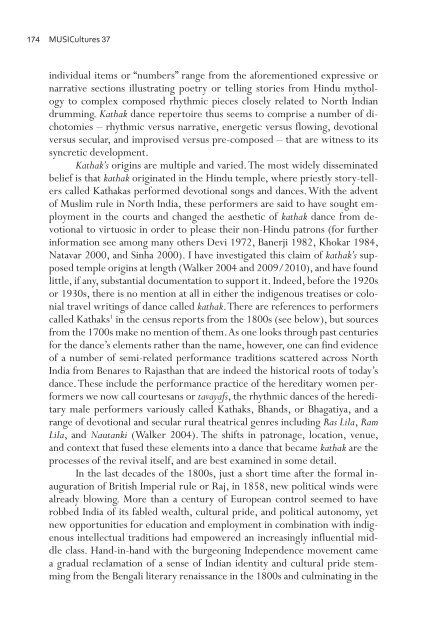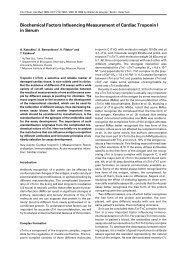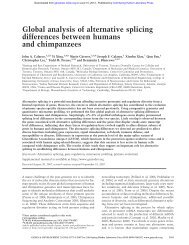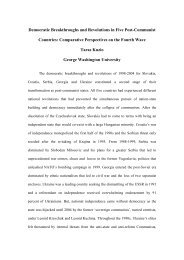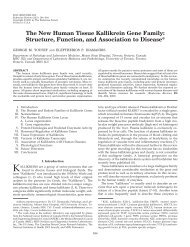revival and reinvention in india's Kathak dance - University of Toronto
revival and reinvention in india's Kathak dance - University of Toronto
revival and reinvention in india's Kathak dance - University of Toronto
Create successful ePaper yourself
Turn your PDF publications into a flip-book with our unique Google optimized e-Paper software.
174 MUSICultures 37<strong>in</strong>dividual items or “numbers” range from the aforementioned expressive ornarrative sections illustrat<strong>in</strong>g poetry or tell<strong>in</strong>g stories from H<strong>in</strong>du mythologyto complex composed rhythmic pieces closely related to North Indi<strong>and</strong>rumm<strong>in</strong>g. <strong>Kathak</strong> <strong>dance</strong> repertoire thus seems to comprise a number <strong>of</strong> dichotomies– rhythmic versus narrative, energetic versus flow<strong>in</strong>g, devotionalversus secular, <strong>and</strong> improvised versus pre-composed – that are witness to itssyncretic development.<strong>Kathak</strong>’s orig<strong>in</strong>s are multiple <strong>and</strong> varied. The most widely dissem<strong>in</strong>atedbelief is that kathak orig<strong>in</strong>ated <strong>in</strong> the H<strong>in</strong>du temple, where priestly story-tellerscalled <strong>Kathak</strong>as performed devotional songs <strong>and</strong> <strong>dance</strong>s. With the advent<strong>of</strong> Muslim rule <strong>in</strong> North India, these performers are said to have sought employment<strong>in</strong> the courts <strong>and</strong> changed the aesthetic <strong>of</strong> kathak <strong>dance</strong> from devotionalto virtuosic <strong>in</strong> order to please their non-H<strong>in</strong>du patrons (for further<strong>in</strong>formation see among many others Devi 1972, Banerji 1982, Khokar 1984,Natavar 2000, <strong>and</strong> S<strong>in</strong>ha 2000). I have <strong>in</strong>vestigated this claim <strong>of</strong> kathak’s supposedtemple orig<strong>in</strong>s at length (Walker 2004 <strong>and</strong> 2009/2010), <strong>and</strong> have foundlittle, if any, substantial documentation to support it. Indeed, before the 1920sor 1930s, there is no mention at all <strong>in</strong> either the <strong>in</strong>digenous treatises or colonialtravel writ<strong>in</strong>gs <strong>of</strong> <strong>dance</strong> called kathak. There are references to performerscalled <strong>Kathak</strong>s 1 <strong>in</strong> the census reports from the 1800s (see below), but sourcesfrom the 1700s make no mention <strong>of</strong> them. As one looks through past centuriesfor the <strong>dance</strong>’s elements rather than the name, however, one can f<strong>in</strong>d evidence<strong>of</strong> a number <strong>of</strong> semi-related performance traditions scattered across NorthIndia from Benares to Rajasthan that are <strong>in</strong>deed the historical roots <strong>of</strong> today’s<strong>dance</strong>. These <strong>in</strong>clude the performance practice <strong>of</strong> the hereditary women performerswe now call courtesans or tavayafs, the rhythmic <strong>dance</strong>s <strong>of</strong> the hereditarymale performers variously called <strong>Kathak</strong>s, Bh<strong>and</strong>s, or Bhagatiya, <strong>and</strong> arange <strong>of</strong> devotional <strong>and</strong> secular rural theatrical genres <strong>in</strong>clud<strong>in</strong>g Ras Lila, RamLila, <strong>and</strong> Nautanki (Walker 2004). The shifts <strong>in</strong> patronage, location, venue,<strong>and</strong> context that fused these elements <strong>in</strong>to a <strong>dance</strong> that became kathak are theprocesses <strong>of</strong> the <strong>revival</strong> itself, <strong>and</strong> are best exam<strong>in</strong>ed <strong>in</strong> some detail.In the last decades <strong>of</strong> the 1800s, just a short time after the formal <strong>in</strong>auguration<strong>of</strong> British Imperial rule or Raj, <strong>in</strong> 1858, new political w<strong>in</strong>ds werealready blow<strong>in</strong>g. More than a century <strong>of</strong> European control seemed to haverobbed India <strong>of</strong> its fabled wealth, cultural pride, <strong>and</strong> political autonomy, yetnew opportunities for education <strong>and</strong> employment <strong>in</strong> comb<strong>in</strong>ation with <strong>in</strong>digenous<strong>in</strong>tellectual traditions had empowered an <strong>in</strong>creas<strong>in</strong>gly <strong>in</strong>fluential middleclass. H<strong>and</strong>-<strong>in</strong>-h<strong>and</strong> with the burgeon<strong>in</strong>g Independence movement camea gradual reclamation <strong>of</strong> a sense <strong>of</strong> Indian identity <strong>and</strong> cultural pride stemm<strong>in</strong>gfrom the Bengali literary renaissance <strong>in</strong> the 1800s <strong>and</strong> culm<strong>in</strong>at<strong>in</strong>g <strong>in</strong> the


